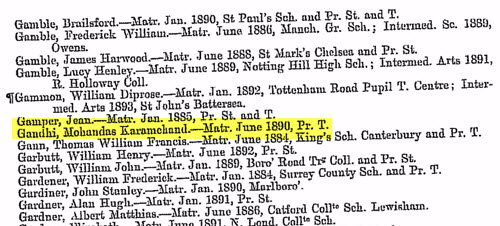by Lisa Cooke | Dec 2, 2016 | 01 What's New, Records & databases
This week in new and updated genealogical collections, enlistment books for five disbanded Irish regiments of the British Army are now available online. Additional collections include records for the Scots Guard, English parish records, Australian funeral notices, New Zealand passenger lists, and Pennsylvania church records.
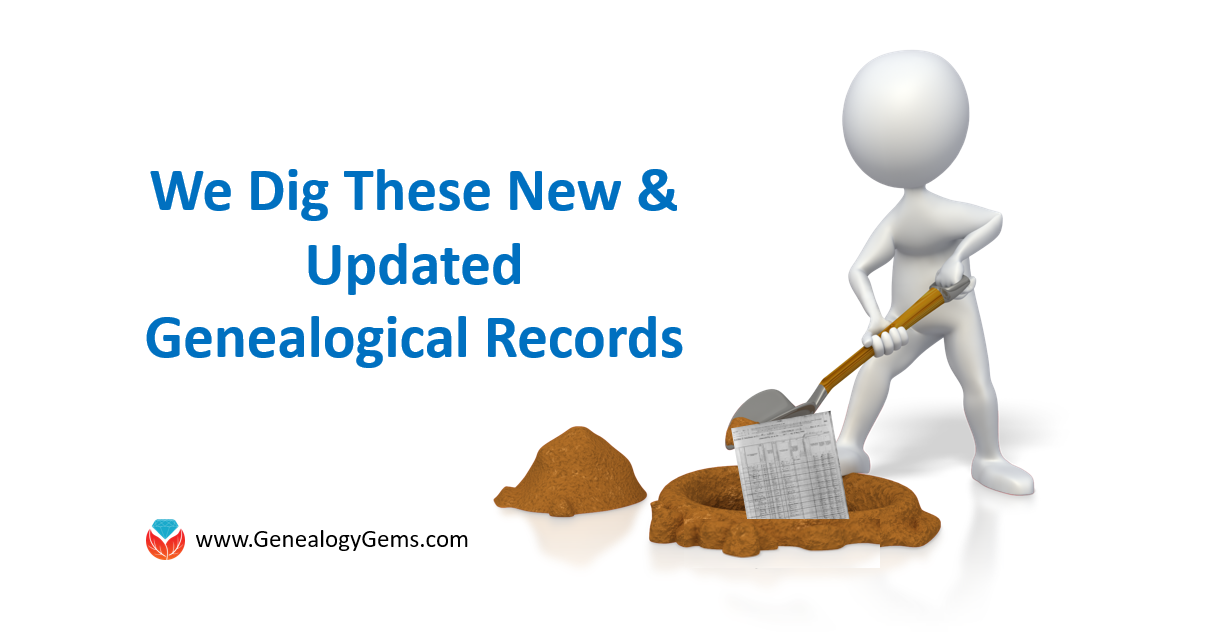
Britain – Military – Disbanded Irish Regiments
The National Army Museum has recently made the enlistment books of the five disbanded Irish regiments available online. This collection allows users to find information on soliders serving in these regiments during 1920-1922.
After the creation of the Irish Free State in 1922, the five regiments of the British Army recruited in southern Ireland – the Royal Irish Regiment, the Connaught Rangers, the Leinster Regiment, the Royal Munster Fusiliers and the Royal Dublin Fusiliers – were disbanded.
These books have now been digitized and for the first time, the records of nearly 12,000 soldiers can be searched online – by unit, place of birth, place of attestation, and year of attestation.
Researchers can see the original scans of each soldier’s entry and may find the recruit’s age and trade on enlistment, names of his next of kin, date of marriage, and the birth date of any children.
The entries also include his address and his rank and character upon discharge.
Britain – Military – Service Records
Over 4,000 records of personnel files and enlistment registers pertaining to the Scots Guards have been added to the British Army Service Records – Scots Guards 1799-1939 at Findmypast. The Scots Guards were one of the Foot Guard regiments of the British Army. They were originally formed to be the personal bodyguards of King Charles I of England and Scotland.
Each record includes a transcript and most include several black and white images of the actual records. The detail within each record may vary, but likely include:
- First and last name
- Birth year and birth place
- Service number (i.e. regimental number)
- Rank, Regiment, and Unit/Battalion
- Residence
England – Cornwall – Church Records
This week at FamilySearch, more records have been added to the England, Cornwall Parish Registers, 1538-2010 collection. This collection contains church records from the counties of Devon and Cornwall, covering the years of 1538-2010. The collection also includes some material for nonconformist chapels which were filmed at the Cornwall Record Office at the time of filming Church of England registers. There are also some typed transcripts of Society of Friends marriages included for certain areas of the county.
Minister’s recorded all the baptisms (officially termed “christenings”), marriages, and burials which took place in his parish each year. These records are wonderful substitutes when the civil records can not be located.
The amount of information found on these christenings, marriages, and burials will vary over time, however, you might expect to find:
- Names and ages of the recorded person
- Parent’s names and residences
- Witnesses names and information
England – Warwickshire – Church Records
Also at FamilySearch, new records have been added to the collection titled England, Warwickshire, Parish Registers, 1535-1984. This collection contains baptismal, banns, marriage, and burial records. Banns and marriage record entries appearing together are the most common in this collection. Approximately half the records in this collection are after 1837 entries, and less than twenty percent are pre-1753.
Australia – Queensland – Funeral Notices
Also at Findmypast, a new collection titled Queensland, Mackay, Funeral notices and funeral director records is now available. In this collection, you will find over 44,000 transcripts of records kept by the local firms Melrose & Fenwick and Mackay Funerals, as well as other funeral notices published in the Daily Mercury. Some of these funeral record indexes may provide your ancestor’s age at death and funeral date. The notices posted in the Daily Mercury cover the years of 1955-2012. These notices may also contain the birth year, burial date, and place of the deceased. These records may be particularly helpful if you have been unable to find a death record for your targeted ancestor.
New Zealand – Passenger Lists
New Zealand, Archives New Zealand, Passenger Lists, 1839-1973 is a helpful collection you will find at FamilySearch. This collection contains immigrant registers from New Zealand, covering the years of 1839 to 1973. The collection contains primarily New Zealand immigration passenger lists, although crew lists make up a significant portion as well. Approximately ten percent of the collection is a mixture of other travel-related documents, including goods manifests.
Some of these record images may be difficult to make out due to ink bleeding through or poor handwriting.
If you are able to find your ancestor listed on one of these passenger lists, you may also find the following information:
- Full name of each passenger
- Adult or child
- Male or female
- Country of emigration
- Port of entry and date of arrival
- Estimated age
- Occupation
- Total cost of passage and how paid
- Name of ship and port of embarkation
United States – Pennsylvania – Baptisms, Burials, & Marriages
Pennsylvania baptisms 1709-1760 at Findmypast contain over 4,500 transcripts of original baptismal records kept by Christ Church in Philadelphia. Each record will likely list a name, birth year, baptism date and location, and the names of both parents, including the mother’s maiden name. Rembmer, baptismal records are a great substitute for a birth record.
If Pennsylvania is your targeted research area, you might also be interested in the collection titled Pennsylvania burials 1816-1849. This group of transcripts number over 1,000 and are the transcripts of the original death records from Susquehanna County. Most records will contain your ancestors name, date of death, and place of burial. They may also include important biographical details such as birth years, occupation, residence, names of parents, and name of spouse.
Lastly, over 17,000 new marriage records for Pennsylvania have been added to the United States Marriages at Findmypast. The entire collection now contains over 140 million records. Each record includes a transcript and an image of the original document that lists the marriage date, the names of the bride and groom, birthplace, birth date, age, residence as well as fathers’ and mothers’ names.
Ireland – Newspapers
Two new titles have been added to the over 177,000 articles in the Irish Newspapers collections at Findmypast. The Tyrone Courier and the Mayo Constitution, are now availabe to search. You will be amazed at the wonderful detail found when using newspapers for genealogy!
More Gems on Military Research
Check out the following helpful articles from our Genealogy Gems blog:
Disclosure: This article contains affiliate links and Genealogy Gems will be compensated if you make a purchase after clicking on these links (at no additional cost to you). Thank you for supporting Genealogy Gems!
by Lisa Cooke | Jan 20, 2017 | 01 What's New, Records & databases
An extraordinary list of European record sets is included in this week’s new and updated genealogical collections. Starting in Ireland and moving across the country, places include: United Kingdom, Belgium, France, Netherlands, and more.
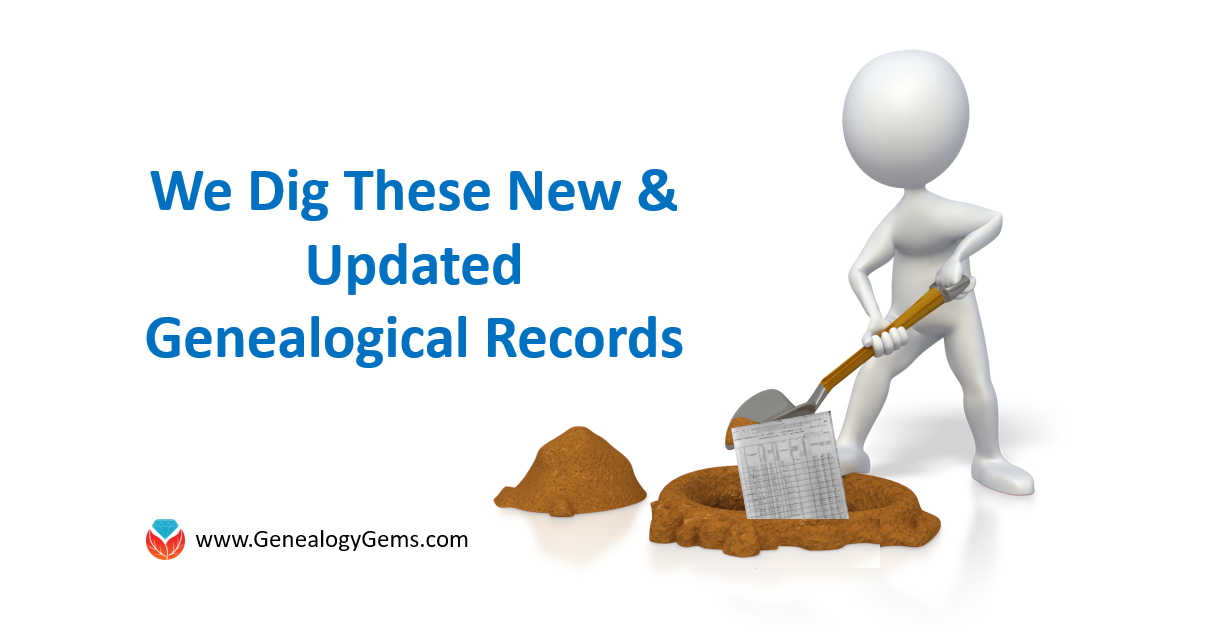
Ireland – Marriage Index
Over 250,000 names have been added to an online database of Irish births, marriages, and deaths. The Irish Genealogical Research Society (IGRS) first created a marriage database in 2014 when it put 40,000 marriage certificates online, and now is adding entries for births and deaths too.
The Early Irish Marriage Index is completely free to all who wish to use it, however, those wishing to browse the Early Irish Birth and Death Indexes are required to take out membership of the IGRS.
United Kingdom – Yorkshire and Derbyshire – Baptisms
Yorkshire & Derbyshire Methodist Baptisms at Findmypast contain over 42,000 for Methodist Churches between 1795 and 1997. The collection covers the densely populated Sheffield district. Sheffield is located in South Yorkshire, traditionally part of the West Riding of Yorkshire, and many of its suburbs stretch into Derbyshire.
Each record will provide you with a transcript created from original church records. The details in each record will vary, but most will include name, birth year, baptism date, denomination, chapel, place, parent’s name, and county.
United Kingdom – Yorkshire & Derbyshire – Methodist Marriages
Also at Findmypast, the Yorkshire & Derbyshire Methodist Marriages collections contains over 22,000 records. These records also cover the Sheffield district. Within the collection, you will find records from eight branches of the Methodist Church: Free Methodist, Methodist, Methodist New Connection, Primitive Methodist, United Free Methodist, United Methodist, Wesleyan Methodist, and Wesleyan Reform Methodist.
Within the collection, you will find records from eight branches of the Methodist Church: Free Methodist, Methodist, Methodist New Connection, Primitive Methodist, United Free Methodist, United Methodist, Wesleyan Methodist, and Wesleyan Reform Methodist.
United Kingdom – Newspapers
Over 1.5 million new articles have been added to Findmypast’s collection of historic British Newspapers. Three brand new titles have also been added; the Cricket and Football Field, Lloyd’s List and the Homeward Mail from India, China and the East.
Lloyd’s List is one of the world’s oldest continuously running journals, having provided weekly shipping news in London as early as 1734. The Homeward Mail from India China and the East will be a huge help for those researching the history of empire, or for those with British or Irish ancestors who lived in India.
United Kingdom – Middlesex – Monumental Inscriptions
Findmypast offers over 12,000 records of Middlesex Monumental Inscriptions for 1485-2014. These monumental inscriptions are from St Nicholas Church, Chiswick.
The records cover the years 1485 to 2014 and include transcripts for each entry. While the amount of available information will vary from transcript to transcript, most will include a combination of name, birth year, death year, dedication, place, monument type, and inscription.
Inscriptions might include the names of others buried in that plot and more specific details regarding age, birth, and death dates. This can be helpful as it can provide you with the names and dates of your ancestor’s next of kin.
Belgium – Civil Registration
FamilySearch’s database titled, Belgium, Namur, Civil Registration, 180 0-1912 is one of the extraordinary European records collections this week. This collection contains primarily civil registration records of births, marriages, and deaths. A few other records are included are marriage proclamations and marriage supplements.
0-1912 is one of the extraordinary European records collections this week. This collection contains primarily civil registration records of births, marriages, and deaths. A few other records are included are marriage proclamations and marriage supplements.
Among the details found in these civil registrations, you will likely find names, dates of vital events, residences, parents’ names, and residences, occupations, and much more.
France – Parish Records
The European records for genealogy continue in this new and updated collection at FamilySearch, the France, Finistère, Quimper et Léon Diocese, Catholic Parish Records, 1772-1894. Though the record set is rather small with only a little over 11, 000 records, this collection consists of name indexes and images of Catholic parish registers recording events of baptism, marriage and burial in the Diocese of Quimper et Léon. Parishes in this diocese lie within the department of Finistère and this collection only contains parishes that start with the letter “A” or “B”.
The following parishes are included:
- Argol
- Arzano
- Audierne
- Bannalec
- Brest-paroisse-Notre-Dame-des-Carmes
- Brest Hospice Civile
- Brest-paroisse-Lambézellec
- Brest-paroisse-Saint-Louis
- Brest-paroisse-Saint-Martin
- Brest-paroisse-Saint-Pierre
Further revisions to the collection will follow as other parishes are published in future.
Netherlands – Misc. Records
FamilySearch has added more European records in the Netherlands, Archival Indexes and they include such records as civil registration, church records, emigration lists, military registers, land records, and tax records. These records cover events like birth, marriage, death, burial, emigration and immigration, military enrollment and more.
The collection continues to grow as records become available, but as of now, the only indexes published on FamilySearch are the Amsterdam Christening Registers from 1564 to 1811 and the burial index from the Regional Archives Rijnlands Midden. For the entire index collection, visit OpenArchives.
Russia – Church Books
Also at FamilySearch, the Russia, Tver Church Books, 1722-1918 are now available. Though only a relatively small number of these records have been indexed, there are over 3 million that have been digitally scanned and are browse-able. Records include births and baptisms, marriages, deaths, and burials performed by priests in the province of Tver (and surrounding provinces) from 1722-1918. These records were originally created at a local level, but were acquired from the state archive in Tver. An index of baptisms is also included.

United States – Maine – Brunswick
There is a unique story of a person who felt the call to serve the genealogy community. Mr. Richard Snow has collected and created an extensive index of articles, pictures, and obituaries from the Brunswick [Maine] Telegraph and the Brunswick Record — forerunners to today’s The Times Record. He then donated his work to the Curtis Memorial Library and it is accessible to you!
The Snow Index will give many a chance to delve into their family’s pasts by accessing the library’s website, a substantial shortcut over previous practices like coming into the library or browsing newspaper websites. This is an index to citations only and not index that leads to full online text. However, with this index as a help, you will likely be able to find the full content with the assistance of the Curtis Memorial Library. Isn’t it great to hear about genealogist’s doing great things? Thank you, Mr. Snow!
United States – Wisconsin – Vital Records
A recent change in state statutes will allow Wisconsin residents to more easily obtain public documents. All Wisconsin register of deeds offices can now issue birth, death, marriage, and divorce records regardless of the county in which the event occurred, as long as the event occurred in Wisconsin.
A statewide database has been created that will allow all offices to access the records. Not all records are available, but the following are:
- Wisconsin births since 1907;
- Deaths since Sept. 1, 2013
- Marriages since June 21, 2015;
- Divorces since Jan. 1, 2016
Be sure to contact the county register of deeds office you plan to visit to make sure they are offering the database at this time. It will likely take a while to get everything up and running!
Ghana – Census
FamilySearch has also added more indexed records to the Ghana Census, 1984. This population census for Ghana is a complete enumeration of the 12.3 million people residing in Ghana as of midnight March 11, 1984. The census is divided into 56,170 localities. According to the government of Ghana, a locality is defined as any “nucleated and physically distinct settlement.” Localities may include a single house, a hamlet, a village, town or city. In some areas of the Upper West and Upper East Regions, these localities are based on kinship groups. Only those individuals, including foreign visitors, who were present in Ghana on March 11, 1984, were included in this census.
There have been some records lost in Ghana and so not all localities are available. Important: Be aware that the printed date on the census enumeration form usually says 1982, but this census was formally conducted in 1984.
The 1984 Ghana census may hold the following information:
- Detailed address of
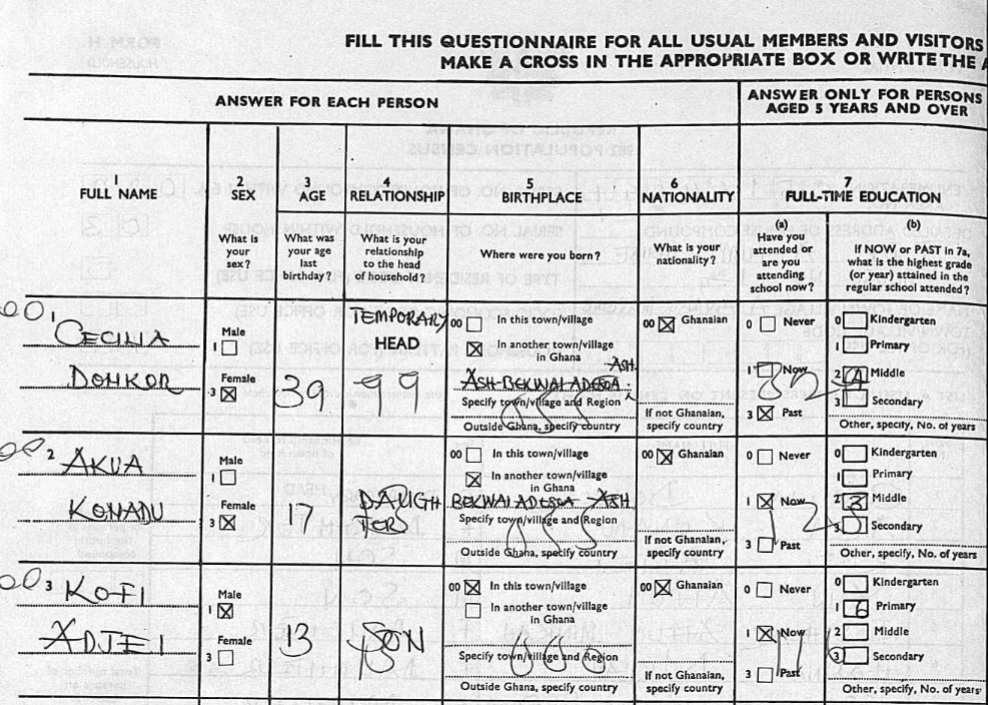 the house
the house
- Name of town/village
- Full name of members present on census night
- Relationship to head of household
- Gender, age, birthpla
ce, and nationality of each individual
- Level of education
- Occupation
- Employment status
- Names of visitors on census night
- Names of members absent on census night
More on Researching European Records for Genealogy
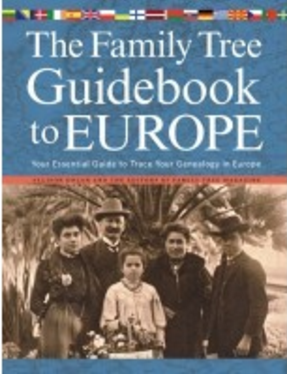 Chart your research course to find your European ancestors with the how-to instruction in this book. This one-of-a-kind collection provides invaluable information about more than 35 countries in a single source. Each of the 14 chapters is devoted to a specific country or region of Europe and includes all the essential records and resources for filling in your family tree.
Chart your research course to find your European ancestors with the how-to instruction in this book. This one-of-a-kind collection provides invaluable information about more than 35 countries in a single source. Each of the 14 chapters is devoted to a specific country or region of Europe and includes all the essential records and resources for filling in your family tree.
Inside you’ll find:
- Specific online and print resources including 700 websites
- Contact information for more than 100 archives and libraries
- Help finding relevant records
- Traditions and historical events that may affect your family’s past
- Historical time lines and maps for each region and country
Disclosure: This article contains affiliate links and Genealogy Gems will be compensated if you make a purchase after clicking on these links (at no additional cost to you). Thank you for supporting Genealogy Gems!
by Lisa Cooke | Nov 17, 2017 | 01 What's New, Genealogy Giants Websites, Records & databases
Enjoy millions of new records from the ‘Genealogy Giants’ websites this week: Ancestry, FamilySearch, Findmypast, and MyHeritage! New collections are now available for England, Ireland, the Netherlands, and Denmark. Also new are two collections of WWII Holocaust records.
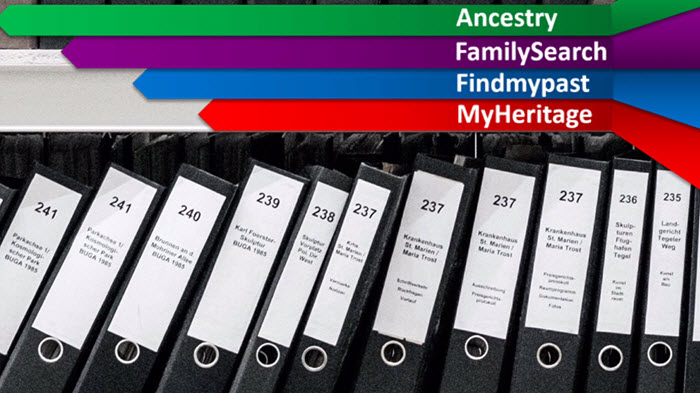
England Records at Findmypast & Ancestry
A massive amount of new records at the ‘Genealogy Giants’ websites were published this week. First up are millions of new English records collections. We’ll start with Findmypast’s new databases:
Surrey, England
- Lay Subsidies 1524-1645: early taxation records from the Tudor and Jacobean periods.
- Court Cases 1391-1835: The records contain cases from four courts and will give you the necessary references for accessing the original records in The National Archives.
- Wills & Probate Index, 1470-1856: The area covered includes the old county of Surrey in the southeast of England, which contains parts of South London.
British Army Records
- Commonwealth War Graves Commission Debt Of Honour: Transcripts will reveal when your ancestor died, their rank, regiment service number, and age at death.
- British Armed Forces, Roman Catholic Registers: The registers comprise records for the British Army, Royal Air Force, and Royal Navy stationed at home and abroad between 1836 and 1975. You can also browse the original registers for this collection.
- British Army Lists 1839-1946: Includes details such as birth date, rank, and unit. You may also browse by year and title.
- East Surrey Regiment 1899-1919: Spanning the Boer War and the First World War, this index may reveal rank, regiment, and battalion, as well as whether your ancestor was wounded or received a medal.
- Railwaymen Died in The Great War: This index of records comes from the National Railway Museum website and may contain details of your ancestor’s pre-war career, military service, and death.
Next, we head to Ancestry for even more new English record collections.
Lastly, FamilySearch has a new collection of Essex Parish Registers, 1538-1997. This collection contains christening, marriage, and burial entries.
Ireland – Findmypast
New at Findmypast for Ireland are British Army, Irish Regimental Enlistment Registers 1877-1924. This collection has enlistment registers from five Irish regiments serving in the British Army. The regiments included in these records are Connaught Rangers, Leinster Regiment, Royal Dunlin Fusiliers, Royal Irish Regiment, and Royal Munster Fusiliers.
A new Irish newspaper title has also been added at Findmypast: the Carrickfergus Advertiser 1884 – 1919. The collection currently contains over 1,300 issues and will be updated further in the future.
Netherlands Public Records at FamilySearch
New at FamilySearch: Netherlands Archival Indexes, Public Records. This collection contains nearly 3 million records that cover events like population registration, emigration and immigration, military enrollment and more.
Denmark – 1930 Census Free at FamilySearch
The Denmark Census, 1930 is now available for free at FamilySearch! “Commonly indexed fields include principle name, locality data, gender, marital status, and relationship to head of household.” The images and index were provided in partnership with MyHeritage.
World War II Holocaust Records and MyHeritage and Ancestry
New at MyHeritage are Auschwitz Death Certificates, 1941-1943. Information listed includes name, birth date, death date, birthplace, residence, and religion. The information originates from the Auschwitz Sterbebücher (Death Books).
Ancestry also has a new collection of Romania select Holocaust Records 1940-1945 (USHMM). This collection is primarily in Romanian, but may also be in Hungarian. It was indexed by World Memory Project contributors from the digitized holdings of the United States Holocaust Memorial Museum.
Get the most out of the top genealogy records websites
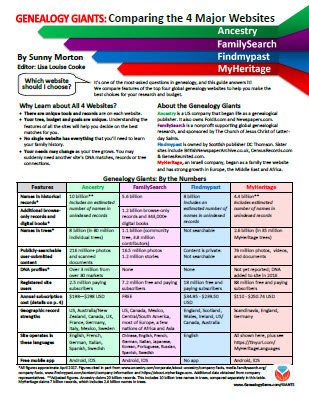 “Which genealogy records membership website should I use?” It’s one of the most-asked questions in genealogy. There are so many features on each site–and an apples-to-apples comparison is laden with challenges. But Genealogy Gems Contributing Editor Sunny Morton has the answers for you in the jammed-packed Genealogy Giants cheat sheet. Use it to quickly and easily compare all of the most important features of the four biggest international genealogy records membership websites: Ancestry.com, FamilySearch.org, Findmypast.com, and MyHeritage.com. Then consult it every time your research budget, needs or goals change. Tables, bulleted lists, and graphics make this guide as easy to use as it is informative. Click here to learn more and grab your copy.
“Which genealogy records membership website should I use?” It’s one of the most-asked questions in genealogy. There are so many features on each site–and an apples-to-apples comparison is laden with challenges. But Genealogy Gems Contributing Editor Sunny Morton has the answers for you in the jammed-packed Genealogy Giants cheat sheet. Use it to quickly and easily compare all of the most important features of the four biggest international genealogy records membership websites: Ancestry.com, FamilySearch.org, Findmypast.com, and MyHeritage.com. Then consult it every time your research budget, needs or goals change. Tables, bulleted lists, and graphics make this guide as easy to use as it is informative. Click here to learn more and grab your copy.
Disclosure: This article contains affiliate links and Genealogy Gems will be compensated if you make a purchase after clicking on these links (at no additional cost to you). Thank you for supporting the free Genealogy Gems podcast and blog!
by Lisa Cooke | Dec 7, 2012 | Genealogy Gems Podcast
[iframe src=”http://html5-player.libsyn.com/embed/episode/id/2151213/height/100/width/480/thumbnail/yes” height=”100″ width=”480″ scrolling=”no”]
In this episode we discuss the latest genealogy news, one listener’s fabulous use of Google Alerts, and Maureen Taylor’s new history film project.
NEWS:
Google Earth 7
Google as just released Google Earth version 7. Google Earth is an amazing tool for genealogy so new enhancements are always welcome! This new version enables you to explore a number of cities around the world in 3D, from Long Beach, California, to Rome, Italy. The 3D imagery uses the enhanced modeling capabilities, previously found on only mobile devices.
In my video CD Google Earth for Genealogy Volume II I go into detail about 3D models and even give you resources for how you can get your own 3D models of everything from your house, to your ancestor’s home.
Download the new Google Earth 7 and get even more 3D imagery. You’ll find comprehensive and accurate tours of more than 11,000 popular sites around the world, including our growing list of cities where new 3D imagery is available.
A big change with this new version is the tour guide feature which serves as sort of a virtual local expert that suggests places nearby that you might want to explore and providing you with background information on the location. You’ll find the tour guide along the bottom of the screen, and it looks like sort of a film strip of thumbnail images representing various tours that are available. These change based on where you are on the Google Earth globe.
List of updated Google Earth imagery
What’s new in RootsMagic 6 Video
And there a favorite genealogy program that just got a new fresh update. RootsMagic 6 is now available, and you can see what’s new in the newest version of the genealogy database program in a brand new video they’ve published on their website at http://www.rootsmagic.com/webinars/
In the video you will see new features in action such as:
- Online Publishing
- Find Everywhere feature
- Live Timeline View
- WebTags
- CountyCheck Explorer
If you are a current paid user of RootsMagic, you can upgrade for just $19.95. New users may purchase RootsMagic 6 for only $29.95. Order online at http://rootsmagic.com/RootsMagic/
Special Holiday Offer Now through Dec. 20, 2012
Order gift copies of RootsMagic 6 for just $19.95 (plus shipping). You can also order other RootsMagic products at that same $19.95 price. Order the special holiday at http://www.rootsmagic.com/holidayoffer or order by phone at 1-800-ROOTSMAGIC (1-800-766-8762).
The next item here is that the Family Tree Service coming soon to FamilySearch.org
According to a FamilySearch press release, “Within the next few months, FamilySearch will make Family Tree available to everyone on its website. The first of many updates planned for FamilySearch.org, Family Tree will provide a free and engaging way to discover, preserve, and share your family history. Family Tree will also offer specialized tools to make temple work for your ancestors even easier and more convenient.
Watch an Introduction to Family Tree that shows 7 reasons to be excited about Family Tree.
Family Tree will enable you to:
- Save family information into a genealogy tree
- Edit and delete incorrect data, including relationships
- Connect and collaborate with others on shared family lines
- Show where information came from
- Link to online photos and documents
If you have questions about what Family Tree will be like or how it will work, you can log in to a special training website that offers online courses, how-to videos, informational handouts, and step-by-step training.
Get started with Family Tree today by watching the introductory video or reading about it on the training website. Family Tree will be open to everyone in the next few months.
RootsTech conference in Salt Lake City
The Early Bird price for the full 3-Day Pass which gives you everything RootsTech has to offer is $149, discounted from the regular full price of $219
Students: One-day only pass for $89 and students can get a 3 day pass with their student ID for just $39
Getting Started 3 Day Pass for beginners: gives you access to over 30 classes in the Beginner track is just $39 for the early bird price, and the regular price will be $49
Getting Started one-day pass giving you access to a selection of fundamental classes for just $19
I will be at RootsTech 2013 teaching a variety of classes in addition to my booth in the exhibit hall, and some free demo classes I’ll be doing in the Demonstration Area of the Expo hall. So I hope you get RootsTech 2013 on your calendar because I look forward to seeing you there.
Ireland – National Archives launches new website
The National Archives of Ireland has launched a new genealogy website at http://www.genealogy.nationalarchives.ie/ which will initially host the 1901 and 1911 Censuses, Tithe Apportionment records from 1823-37, and Soldiers’ Wills from 1914-17.
New at ScotlandsPeople
Scottish wills and testaments from 1902-25 now online at the ScotlandsPeople at http://www.scotlandspeople.gov.uk/
Millions of Old Newspaper pages added to FindMyPast
findmypast.com has just published millions of pages of historical newspapers from not only England, but also across Wales and Scotland as well. This collection contains local newspapers for the period 1710-1950. More than 200 titles are included. Go to http://www.findmypast.co.uk/search/newspapers
Ancestry.com launches newspapers.com
On November 29, 2012 Ancestry.com Inc., announced the launch of Newspapers.com, a web site designed to offer a collection of more than 800 U.S. newspapers dating from the late 1700s into the early 2000s.
Comprising more than 25 million pages, Newspapers.com offers a historical and present-day newspapers ranging from the New York Times to small town and local newspapers throughout the United States.
According to Ancestry’s press release “The search capabilities on Newspapers.com are specifically designed for newspapers enabling users to easily search by keywords, location, time period and newspaper name.”
The yearly subscription rate is $79.95 for subscribers and $39.95 for Ancestry.com or Fold3.com members. Newspapers.com also offers a 7-day free trial that can be activated at www.newspapers.com.
Ancestry has launched a new Community Support site at Ancestry.com
You can access Community Support by clicking on “Get Help” at the top of the Ancestry.com homepage. Once on Online Help, you will see a button for “Ask the Community” on the right hand side. That link will take you directly to Ancestry’s new Support Communities.
MyHeritage Buys Geni.com
MyHeritage have just bought our long-term rival Geni.com – and also raised $25million in new funds. As a larger community, the users of MyHeritage and Geni.com will now receive matches with the other website family trees, and MyHeritage’s Record Matching, will benefit Geni’s users, who will get access to historical records never available before on Geni.com.
MAILBOX:
Jessica has a new blog and a question about photo storage: “…after about the 10th podcast in a row where you encouraged us to start our own blog, I finally got the message. I started my very own “geneablog” a couple of weeks ago. I only have three posts so far, but I’m pretty proud of it. Please check it out and let me know what you think. I’d love you to let your listeners know too, because that would be even more feedback! I am writing my blog from the perspective of my relentless quest to better understand the life of one particular ancestor of mine, William Park. I call it “Knowing William” and it writing it really makes me happy.” Visit her blog at http://williamparkfamilyhistory.blogspot.com/
“I recently listened to episode 119 where you talked to Michael Katchen from 1000memories. I went to the site, signed up, and uploaded pics to my first shoe box. In the interview I remember words like “social networking”, “memorials”, and “genealogy”. I am confused. All I saw on the site was my shoe boxes and some not-very-informative FAQs. I know it has been a while, but have they changed the whole premise of the website in less than a year?”
Lisa’s Answer: Congrats on your new blog! Remember posts can be short and sweet, and pack them with searchable keywords so other researchers can find you in Google Search.
RE: 1000Memories. They have indeed changed up the website since the interview. I agree with you, it seems watered down now, and not as obvious as to how to make the most of it. They seem to be focused on “simplicity.”
Barbara Shares A New Use for Google Alerts
“My Great Grandfather, Edmund Charles Clark, was a builder in Bendigo, and many of his houses still stand in Wattle Street Bendigo today. I spent a lovely day photographing them, but I cannot go up and knock on all the doors however! So I have a cute way of finding out just what those houses look like today especially on the inside. I have an alert in Google for “Wattle Street, Bendigo” and it works a treat. Every so often one of the homes goes up for sale or rent, and one of the real estate websites has pictures of both inside and outside. These come up on my search and I get to see inside the homes that are still standing. One is up for rent at present and here are the pictures from Realestate.com.au of 172 Wattle Street. Isn’t it lovely? It is still much in original condition.
The Google alert function is really useful for genealogy, and I first found out about it from Genealogy Gems – so thank you very much for the gem.”



GEM: Maureen Taylor’s new gig – bringing revolutionary war history to film
Pamela Pacelli Cooper, President, Verissima Productions at www.verissima.com
Maureen Taylor, Author of The Last Muster
Revolutionary Voices: A Last Muster Film, Directed by Maureen Taylor with Verissima Productions
Visit Film Site: lastmusterfilm.com
New Gem for Premium Members!
Sign in to your Membership and go to Premium Videos to view the brand new video Genealogy on the Go with the iPad (and tablets too!)
The iPad is built for hitting the road and is ideally suited for family history due to its’ sleek lightweight size, gorgeous graphics and myriad of apps and tools. In this class I will teach you “the tablet mindset”, the best apps for the tasks that genealogists want to accomplish, and my Top 10 list of iPad Tips and Tricks. By the end of class you will be able to turn your iPad into a family history powerhouse!

Become a Premium Member Here
Check out this episode



 0-1912
0-1912
 the house
the house

